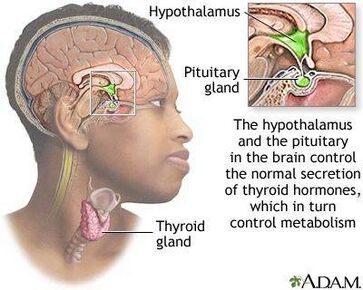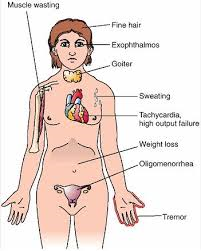Thyroid Storm (Thyroid Crisis): Difference between revisions
No edit summary |
Kim Jackson (talk | contribs) m (Text replacement - "Grave's Disease" to "Graves' Disease") |
||
| (One intermediate revision by one other user not shown) | |||
| Line 10: | Line 10: | ||
Thyroid storm: | Thyroid storm: | ||
* Most commonly seen in the context of underlying [[ | * Most commonly seen in the context of underlying [[Graves' Disease|Graves']] disease but can complicate thyrotoxicosis of any aetiology.<ref name=":1">Carroll R, Matfin G. Endocrine and metabolic emergencies: thyroid storm. Therapeutic advances in endocrinology and metabolism. 2010 Aug;1(3):139-45. Available:https://www.ncbi.nlm.nih.gov/pmc/articles/PMC3475282/ (accessed 23.2.2022)</ref> | ||
* Accounts for about 1% to 2% of admissions for hyperthyroidism.<ref name=":0" /> | * Accounts for about 1% to 2% of admissions for hyperthyroidism.<ref name=":0" /> | ||
| Line 22: | Line 22: | ||
Physical examination findings may include high temperature, tachycardia, orbitopathy, goiter, hand tremors, moist and warm skin, hyperreflexia, systolic [[hypertension]], and jaundice.<ref name=":0" /> | Physical examination findings may include high temperature, tachycardia, orbitopathy, goiter, hand tremors, moist and warm skin, hyperreflexia, systolic [[hypertension]], and jaundice.<ref name=":0" /> | ||
== Etiology == | |||
Thyroid storm is most commonly associated with underlying Graves' disease, although has been reported with autonomous thyroid nodular disease. | |||
Traditionally, the condition was experienced frequently following thyroidectomy for thyrotoxic state, but modern treatments aimed at reducing preoperative thyroid output and hormone stores have dramatically reduced this complication. | |||
The rare transition to a state of thyroid storm usually requires a second superimposed insult. Most commonly this is infection, although trauma, surgery, myocardial infarction (MI), diabetic ketoacidosis (DKA), pregnancy and parturition have been reported as causes.<ref name=":1" /> | |||
== Management== | == Management== | ||
[[File:Icu.jpg|thumb|360x360px|Throid storm managed in ICU]] | |||
Thyroid storm is a rare life-threatening medical emergency and is difficult to diagnose. An interprofessional team including an intensivist, cardiologist, endocrinologist, internist, emergency department physician, and infectious disease expert is recommended. | Thyroid storm is a rare life-threatening medical emergency and is difficult to diagnose. An interprofessional team including an intensivist, cardiologist, endocrinologist, internist, emergency department physician, and infectious disease expert is recommended. | ||
| Line 29: | Line 37: | ||
Treatment of thyroid storm consists of supportive measures eg intravenous (IV) fluids, [[Oxygen Therapy|oxygen]], cooling blankets, acetaminophen, as well as specific measures to treat hyperthyroidism. If any precipitating factors, eg an [[Infectious Disease|infection]], are present, they need to be taken care of first. Patients with thyroid storm must be admitted to the intensive care unit with close cardiac monitoring and [[Ventilation and Weaning|ventilatory]] support as needed.<ref name=":0" /> | Treatment of thyroid storm consists of supportive measures eg intravenous (IV) fluids, [[Oxygen Therapy|oxygen]], cooling blankets, acetaminophen, as well as specific measures to treat hyperthyroidism. If any precipitating factors, eg an [[Infectious Disease|infection]], are present, they need to be taken care of first. Patients with thyroid storm must be admitted to the intensive care unit with close cardiac monitoring and [[Ventilation and Weaning|ventilatory]] support as needed.<ref name=":0" /> | ||
== Physical Therapy Management == | == Physical Therapy Management == | ||
[[File:Clinicians in Intensive Care Unit.jpg|thumb|Clinicians in Intensive Care Unit]] | |||
Requires immediate medical attention | Requires immediate medical attention | ||
When medical attention is required?: In a patient experiences the following, especially those with a history of Hyperthyroidism or Graves’ Disease: | |||
*Tachycardia | *Tachycardia | ||
| Line 51: | Line 52: | ||
*Altered consciousness | *Altered consciousness | ||
What should be monitored during treatment session?: [[Vital Signs|Vital signs]] including: [[Blood Pressure|blood pressure]], [[Heart Rate|heart rate]], and [[Respiratory Rate|respiratory rate]]. | |||
Other signs: excessive sweating, shortness of breath, abnormal tenderness with palpation of the thyroid gland, abnormal heart sounds, fever, tremor, and any of the clinical signs listed above. | Other signs: excessive sweating, shortness of breath, abnormal tenderness with palpation of the thyroid gland, abnormal heart sounds, fever, tremor, and any of the clinical signs listed above. | ||
Latest revision as of 16:58, 1 March 2022
Original Editors - Chelsea Reed & Tory Schwartz from Bellarmine University's Pathophysiology of Complex Patient Problems project.
Top Contributors - Chelsea Reed, Elaine Lonnemann, Lucinda hampton, Kim Jackson, WikiSysop and Adam Vallely Farrell
Introduction[edit | edit source]
Thyroid storm (first described in 1926) is an acute, life-threatening complication of hyperthyroidism that presents with multi-system involvement. It is an endocrine emergency and remains a diagnostic and therapeutic challenge. No laboratory abnormalities are specific to thyroid storm, and the available scoring system is based on the clinical criteria. [1] The mortality associated with thyroid storm is estimated to be 8-25% despite modern advancements in its treatment and supportive measures.[2]
Thyroid storm:
- Most commonly seen in the context of underlying Graves' disease but can complicate thyrotoxicosis of any aetiology.[3]
- Accounts for about 1% to 2% of admissions for hyperthyroidism.[2]
Characteristics/Clinical Presentation[edit | edit source]
Presentation of thyroid storm is an exaggerated manifestation of hyperthyroidism, with the presence of an acute precipitating factor. Presenting features:
- Fever of 104 F to 106 F with diaphoresis is a key presenting feature,
- Cardiovascular involvement (including tachycardia, heart failure, arrhythmia),
- Central nervous system (CNS) manifestations
- Gastrointestinal symptoms are common.
Physical examination findings may include high temperature, tachycardia, orbitopathy, goiter, hand tremors, moist and warm skin, hyperreflexia, systolic hypertension, and jaundice.[2]
Etiology[edit | edit source]
Thyroid storm is most commonly associated with underlying Graves' disease, although has been reported with autonomous thyroid nodular disease.
Traditionally, the condition was experienced frequently following thyroidectomy for thyrotoxic state, but modern treatments aimed at reducing preoperative thyroid output and hormone stores have dramatically reduced this complication.
The rare transition to a state of thyroid storm usually requires a second superimposed insult. Most commonly this is infection, although trauma, surgery, myocardial infarction (MI), diabetic ketoacidosis (DKA), pregnancy and parturition have been reported as causes.[3]
Management[edit | edit source]
Thyroid storm is a rare life-threatening medical emergency and is difficult to diagnose. An interprofessional team including an intensivist, cardiologist, endocrinologist, internist, emergency department physician, and infectious disease expert is recommended.
These patients are best managed in the ICU. Nurses need to be fully aware of the potential complications and notify the physician if there is any change in the hemodynamic status.
Treatment of thyroid storm consists of supportive measures eg intravenous (IV) fluids, oxygen, cooling blankets, acetaminophen, as well as specific measures to treat hyperthyroidism. If any precipitating factors, eg an infection, are present, they need to be taken care of first. Patients with thyroid storm must be admitted to the intensive care unit with close cardiac monitoring and ventilatory support as needed.[2]
Physical Therapy Management[edit | edit source]
Requires immediate medical attention
When medical attention is required?: In a patient experiences the following, especially those with a history of Hyperthyroidism or Graves’ Disease:
- Tachycardia
- Palpitations
- Hyperthermia
- Excessive sweating
- Abdominal pain
- Nausea and vomiting
- Altered consciousness
What should be monitored during treatment session?: Vital signs including: blood pressure, heart rate, and respiratory rate.
Other signs: excessive sweating, shortness of breath, abnormal tenderness with palpation of the thyroid gland, abnormal heart sounds, fever, tremor, and any of the clinical signs listed above.
Hyperthyroidism and Exercise (see hyperthyroidism)
Case Reports/ Case Studies[edit | edit source]
Thyroid Storm during induction of anesthesia http://www.ncbi.nlm.nih.gov/pmc/articles/PMC3506864/
Case report of a 50 year old woman who experienced a thyroid storm during anesthesia induction for a humeral fracture repair. Patient presented with no history of hyperthyroidism nor abnormal signs preoperatively. However, reported weight loss, intermittent palpitations, and hand tremors for the past year.
References[edit | edit source]
- ↑ Chiha M, Samarasinghe S, Kabaker AS. Thyroid storm: an updated review. Journal of intensive care medicine. 2015 Mar;30(3):131-40.Available: https://pubmed.ncbi.nlm.nih.gov/23920160/ (accessed 23.2.2022)
- ↑ 2.0 2.1 2.2 2.3 Pokhrel B, Aiman W, Bhusal K. Thyroid storm. Available: https://www.ncbi.nlm.nih.gov/books/NBK448095/(accessed 23.2.2022)
- ↑ 3.0 3.1 Carroll R, Matfin G. Endocrine and metabolic emergencies: thyroid storm. Therapeutic advances in endocrinology and metabolism. 2010 Aug;1(3):139-45. Available:https://www.ncbi.nlm.nih.gov/pmc/articles/PMC3475282/ (accessed 23.2.2022)










